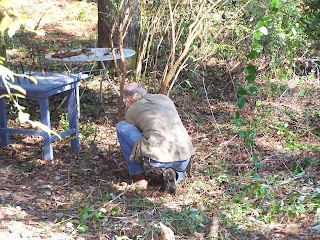Make a personal investment in the woods.
It doesn’t have to be a vast tract of woods.
You don’t have to move to the woods to experience it.
We must admit, however, that moving to the woods suits
our personal dispositions much better than the other modes of living we’ve
known. It would be extremely difficult for us to return to what we often
referred to as living in the ruburbs.
Ruburbs?
The area just out past the suburbs full of lookalike
houses.
The area that was once, in my memory, the rural farmlands separated by overgrown
fencerows and large woodlots where I wandered for miles around with a well-worn
hand-me-down .22 single shot. The property owners didn’t mind. It was a way of
life for us. That way of life is sadly gone. That area is gone. Replaced now
with a hodgepodge of small acreages with huge houses and lawns.
You don’t have to own it.
You just need to be able to get on it.
Preferably with the owner’s permission if the woodlot
is privately owned. There’s also Municipal, State, and Federal lands that offer
opportunities for folks to invest themselves. These latter three may very well
have an assortment of restrictions that users need to be aware of and pay
attention to. Making fires and messing with the habitat can, for good reasons,
be sticky issues. Respect the restrictions.
Every woodlot, even a small one on the edge of town,
has something to offer. Even if it is only for educational and photographic
purposes. Especially when the woodlot has been left undisturbed as a natural
area long enough that the natural elements
of nature have had an opportunity to prevail against the ravages of human
progress. That’s the way it is with nature.
 Nature, given the opportunity, will reclaim itself
from the effects of the dozer, excavator, and plow. It’s amazing how that
works.
Nature, given the opportunity, will reclaim itself
from the effects of the dozer, excavator, and plow. It’s amazing how that
works.
Use the natural world but don’t abuse it. Draw from it
without devastating it. Learn to co-exist
with nature rather than striving to conquer
it.
I think, at this stage of human development, that this is probably one of the hardest lessons that
any of us humans can learn. The reality that the natural world is an ally to be
cared for can’t be overplayed or overstated. The natural world, after all, has
supplied human beings with all the essentials for life on every continent for the entire existence of humanity.
So much of life today involves constant hustle and
bustle … hurry up and get it done … day in and day out. That pace has a way of
following us when we exit the concrete sidewalks and paved streets and wander
into the woods. We go into the woods in a hurry. We move around in the woods in
a hurry. Then we leave the woods in a hurry to go back to the hurry that we
went to the woods to escape.
We, as a result of hurrying, miss a lot. There is a
lot that we fail to observe. There is
a lot that we fail to experience. We
miss and fail that lot because nature’s first invitation was left unanswered.
Nature’s first invitation?
It is something that seems unnatural and unproductive
to us at first. Once we get onto it … once we realize that it is perfectly
natural … once we tune ourselves to its wavelength … it’s hard to turn the dial
to any other station.
Slow
down.





































